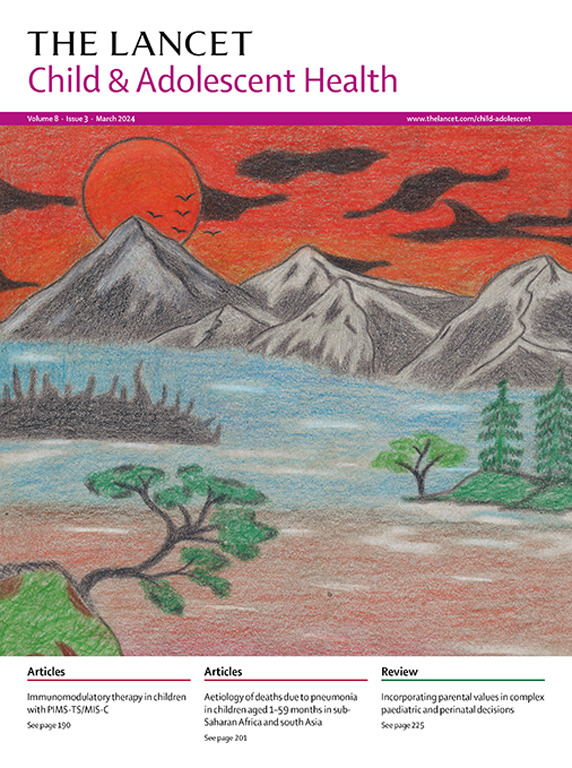Immunogenicity and safety of a measles and rubella-containing vaccine at age 6 and 9 months in Bangladesh: an open-label, randomised trial
IF 19.9
1区 医学
Q1 PEDIATRICS
引用次数: 0
Abstract
Background
The first dose of measles–rubella (MR) vaccine is routinely administered to infants aged 9 months as part of a standard two-dose schedule. However, during large measles outbreaks and in other settings of increased circulation or increased risk, WHO recommends administering a supplementary dose at age 6 months to protect young infants. We aimed to assess the immunogenicity and safety of a first dose of MR vaccine administered to infants aged 6 months and its effect on the immune response to the routine MR vaccine at age 9 months.
Methods
This open-label, randomised trial enrolled healthy infants aged 6 months in Matlab, Bangladesh, who had never received an MR vaccine dose and had no history of measles or rubella. Using a computer-generated block randomisation scheme, infants were randomly assigned (1:1) to receive either two doses of the MR vaccine, one at age 6 months and the second at age 9 months (two-dose group), or one dose at age 9 months (one-dose group). Baseline characteristics were recorded for all enrolled participants at age 6 months. Blood samples were drawn for antibody assays before each vaccination and at final follow up when infants were aged 11 months. The primary outcome was immunogenicity of a first MR vaccine in infants aged 6 months or 9 months and the immunogenicity of a second MR vaccine in infants aged 9 months who received their first MR vaccine at 6 months. Immunogenicity was measured as the proportion of infants who seroconverted in the 12 weeks after vaccination at age 6 months or the 8 weeks after vaccination at age 9 months. Seroconversion was defined as a 4-times increase in IgG concentrations relative to the pre-vaccination concentrations or achieving seroprotective antibody concentrations between study timepoints. The modified intention-to-treat analysis included all infants who received MR vaccines per group assignment and had antibody results at baseline, 9 months, and 11 months. All enrolled infants were included in the safety analysis of the immediate reactions (observed by study staff at the fixed-site clinic in the first 30 min after vaccination), adverse events within 48 h of vaccination among infants in the two-dose group receiving their first MR vaccine at age 6 months, and adverse events observed by study staff or parents at any time during the study. The trial is registered on ClinicalTrials.gov, NCT03071575, and is closed to enrolment.
Findings
Between March 9, 2017, and March 18, 2018, 620 infants were enrolled and randomly assigned to the two study groups (312 in the two-dose group and 308 in the one-dose group). Of the 301 infants vaccinated at 6 months, 282 seroconverted for measles (94%, 95% CI 90–96), and 283 seroconverted for rubella (94%, 91–96). By 11 months, after receiving a second dose at age 9 months, 297 (cumulative 99%, 95% CI 97–100) infants seroconverted for measles and 297 infants seroconverted for rubella (cumulative 99%, 96–100). Of the 292 infants vaccinated at 9 months only, 291 seroconverted for both antigens by age 11 months (100%, 95% CI 98–100). 123 adverse events were observed; 72 in the two-dose group and 51 in the one-dose group, with no differences in severity (p=0·78) or outcomes (p=0·71) by study group. 12 (17%) events in the two-dose group and seven (14%) in the one-dose group were severe; most events were mild, resolved without sequelae, and were unrelated to the MR vaccine. One death occurred in the one-dose group before the infant received the 9-month dose of the vaccine, and therefore was deemed to be unrelated to the MR vaccine.
Interpretation
The data presented support use of MR vaccine at 6 months to protect young infants during measles outbreaks and in settings with increased risk or high transmission. We recommend additional studies to evaluate longer-term immunity based on age at vaccination.
Funding
US Centers for Disease Control and Prevention.
Translations
For the French and Spanish translations of the abstract see Supplementary Materials section.
孟加拉国6个月和9个月含麻疹和风疹疫苗的免疫原性和安全性:一项开放标签随机试验
背景:麻疹风疹(MR)疫苗的第一剂常规接种于 9 个月大的婴儿,是标准两剂接种计划的一部分。然而,在麻疹大规模暴发期间以及在其他麻疹流行加剧或风险增加的情况下,世卫组织建议在婴儿满 6 个月时接种一剂补充疫苗,以保护年幼婴儿。我们的目的是评估 6 个月大婴儿接种第一剂麻疹疫苗的免疫原性和安全性及其对 9 个月大常规麻疹疫苗免疫反应的影响:这项开放标签随机试验招募了孟加拉国马特拉布 6 个月大的健康婴儿,这些婴儿从未接种过 MR 疫苗,也没有麻疹或风疹病史。通过计算机生成的整群随机方案,婴儿被随机分配(1:1)接种两剂 MR 疫苗,一剂在 6 个月大时接种,第二剂在 9 个月大时接种(两剂组),或一剂在 9 个月大时接种(一剂组)。所有参加者在 6 个月大时的基线特征均已记录。在每次接种疫苗前和婴儿 11 个月大时的最后随访中,均抽取血液样本进行抗体检测。主要结果是 6 个月或 9 个月婴儿首次接种 MR 疫苗的免疫原性,以及在 6 个月时首次接种 MR 疫苗的 9 个月婴儿第二次接种 MR 疫苗的免疫原性。免疫原性以 6 个月大时接种疫苗后 12 周内或 9 个月大时接种疫苗后 8 周内血清转换的婴儿比例来衡量。血清转换的定义是:IgG 浓度比接种前增加 4 倍,或在研究时间点之间达到血清保护性抗体浓度。修改后的意向治疗分析包括所有按组接种 MR 疫苗并在基线、9 个月和 11 个月时获得抗体结果的婴儿。所有参加试验的婴儿都纳入了安全性分析,包括即时反应(由固定地点诊所的研究人员在接种后 30 分钟内观察到)、接种后 48 小时内两剂组中在 6 个月大时首次接种 MR 疫苗的婴儿发生的不良反应,以及研究人员或家长在研究期间任何时候观察到的不良反应。该试验已在ClinicalTrials.gov上注册,编号为NCT03071575,目前已结束报名:2017年3月9日至2018年3月18日期间,620名婴儿被注册并随机分配到两个研究组(312名婴儿在两剂组,308名婴儿在一剂组)。在6个月时接种疫苗的301名婴儿中,282名婴儿的麻疹血清转换率为94%,95% CI为90-96,283名婴儿的风疹血清转换率为94%,91-96。到 11 个月时,在 9 个月大时接种第二剂疫苗后,297 名婴儿(累计 99%,95% CI 97-100)的麻疹血清转换率和 297 名婴儿的风疹血清转换率(累计 99%,96-100)。在 292 名仅在 9 个月大时接种疫苗的婴儿中,有 291 名在 11 个月大时对两种抗原都产生了血清转换(100%,95% CI 98-100)。共观察到 123 例不良事件;72 例发生在两剂组,51 例发生在单剂组,各研究组在严重程度(P=0-78)或结果(P=0-71)上无差异。两剂组中有 12 例(17%)严重不良反应,单剂组中有 7 例(14%)严重不良反应;大多数不良反应较轻,且无后遗症,与 MR 疫苗无关。一剂组中有一名婴儿在接种9个月的疫苗前死亡,因此被认为与MR疫苗无关:所提供的数据支持在麻疹暴发期间以及在麻疹风险增加或传播率高的环境中使用6个月的MR疫苗来保护幼儿。我们建议开展更多研究,根据接种年龄评估更长期的免疫力:美国疾病控制和预防中心:摘要的法文和西班牙文译文见补充材料部分。
本文章由计算机程序翻译,如有差异,请以英文原文为准。
求助全文
约1分钟内获得全文
求助全文
来源期刊

Lancet Child & Adolescent Health
Psychology-Developmental and Educational Psychology
CiteScore
40.90
自引率
0.80%
发文量
381
期刊介绍:
The Lancet Child & Adolescent Health, an independent journal with a global perspective and strong clinical focus, presents influential original research, authoritative reviews, and insightful opinion pieces to promote the health of children from fetal development through young adulthood.
This journal invite submissions that will directly impact clinical practice or child health across the disciplines of general paediatrics, adolescent medicine, or child development, and across all paediatric subspecialties including (but not limited to) allergy and immunology, cardiology, critical care, endocrinology, fetal and neonatal medicine, gastroenterology, haematology, hepatology and nutrition, infectious diseases, neurology, oncology, psychiatry, respiratory medicine, and surgery.
Content includes articles, reviews, viewpoints, clinical pictures, comments, and correspondence, along with series and commissions aimed at driving positive change in clinical practice and health policy in child and adolescent health.
 求助内容:
求助内容: 应助结果提醒方式:
应助结果提醒方式:


